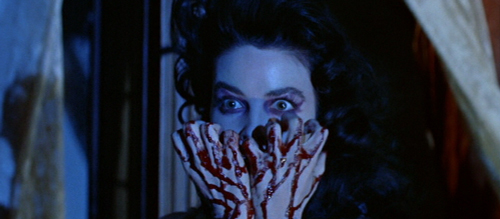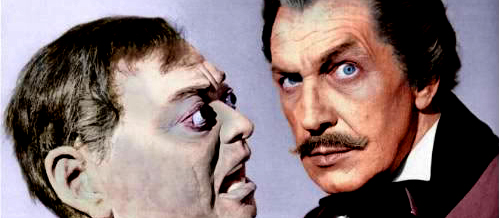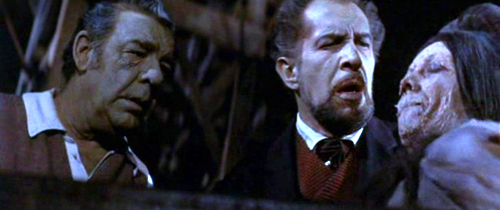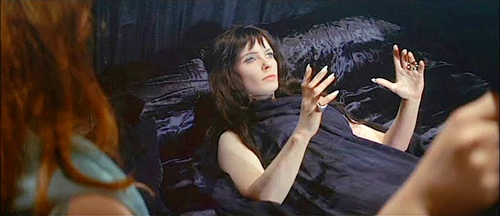Reviewed by Glenn Erickson
Last year Scream (Shout!) Factory gave us two Blu-ray collections of Vincent Price horror titles, all looking and sounding great. This December U.K. horror fans will get their due with Arrow Video's Region B box Vincent Price in Six Gothic Tales by Edgar Allan Poe. All the films in this grouping were produced and directed by Roger Corman; all the key Price/Corman/Poe collaborations are here save for 1964's The Masque of the Red Death, for which the U.K. rights are held by a different distributor. But American fans can't gloat, for this U.K. box contains its own exclusive, 1963's Tales of Terror.
Why might American collectors take interest? Arrow has augmented the six titles with desirable, exclusive extras including some long-form documentaries and new interview pieces. I'll list and comment on these extras with the individual titles. The transfers come from the same source as the American releases; I'll discuss them further down the page.

1960's The Fall of the House of Usher earned considerable industry respect for Roger Corman, who was previously dismissed as a maker of cheap B&W drive-in attractions. I remember staring at A.I.P.'s sensational poster, which showed figures descending flights of stairs that crisscrossed the artwork, down to an open coffin at the bottom. Even the typeface on the lettering was creepy-looking. At age eight I didn't yet know who Frankenstein and Dracula were, so that poster was probably my first contact with horror movie iconography.
Forget the occasional slipshod nature of Corman's earlier efforts, as he maintains full control of this larger-scale production. While Les Baxter's romantic score works up an effective haunted house mood, Floyd Crosby's camera records Vincent Price as a strangely frail, white-haired victim of some strange malady of body and soul. Price's Roderick Usher makes us feel the concept of a man hypersensitive to every sensation -- touch, sound, light -- as if he were allergic to being alive. The film alludes to incest between Usher and his sister Madeline (Myrna Fahey) and suggests that Roderick is twisted in other, secret ways that seem beyond our understanding. The supposed hero (Mark Damon) is a real third wheel in the setup -- we know that his attempts to rescue Madeline from her 'unusual' home situation will come to nothing.
The movie is a bit over-lit, and I'd have to say that although Daniel Haller's sets are indeed elaborate for a small film, they still have that hasty "wild wall" design look. Yet Corman, Crosby, Haller and screenwriter Richard Matheson excel in the horror highlights. The trips to the crypt are spooky, as are the tinted dream sequences. When nobody at a funeral notices that the corpse is alive and twitching, Corman uses the wide screen to excellent effect. Couple that with views of the house's crumbling exterior walls and a killer shot of Madeline's crazed eyes behind bloody hands, and The Fall of the House of Usher has at least ten horror images to imprint into impressionable young minds.
The Usher extras align with their earlier single title Blu-ray release. 'Exclusive' items are featurettes with Joe Dante, and Jonathan Rigby and a visual essay by David Cairns. (all extras for individual titles are listed below.)

1961's The Pit and the Pendulum delivers Usher's chills plus action, violence and barnstorming performances. Richard Matheson extended Poe's terrifying short story (which is limited to one scene in the torture pit) by repeating Usher's handsome young man come to find out what became of a beautiful woman. This time the setting is a castle in Spain, with a budget stretched to accommodate more impressive sets, special effects and two extra name stars. John Kerr manages to avoid ridicule in his frilly Spanish costume, while newly minted horror queen Barbara Steele provides the perfidious spark to ignite a burst of gruesome violence. Matheson's backstory gives Vincent's Nicholas Medina a father whose hobby was maintaining a Torquemda-approved torture dungeon. A premature burial plays a big role as well, with a nightmarish desiccated corpse appearing for one quick, indelible flash image.
This time out Vincent Price begins as a disturbed widower, proceeds to a state of guilty delirium and finally go completely nuts. Nicholas takes on his father's fanatical desire to get that torture chamber in operation again. Some say Price's characterization goes a bit too far, what with Nicholas alternating between infantile giddiness and (verbally eloquent) hyper-malice. Price certainly overpowers Barbara Steele's impressive turn as the wicked wife, Elizabeth. Most of the beauties described by Edgar Allan Poe were virtuous but Elizabeth is so nasty that she can't stop gloating. She foolishly underestimates Nicholas's ability to function while in a state of stark raving madness.
The finish sees John Kerr keeping his traumatic appointment with the unpleasant title contraption. Pit and the Pendulum is probably the Corman/Poe picture with the highest thrills-per-minute rating. The "gotcha!" stinger he reserves for the fade-out (or ragged iris-out) shows excellent directorial control. I'd bet that even Alfred Hitchcock enjoyed the macabre final shot. Two Poe pictures into his series, Roger Corman has two unqualified winners.
Pit's exclusive extras start with an isolated track for Les Baxter's odd score, that alternates romantic violins with strange percussive pieces. Behind the Swinging Blade is an overlong documentary that nevertheless has what we all want to see -- Barbara Steele in a candid mood and Roger Corman reaching beyond his usual ten stories about the film. Ms. Steele really seems to be having fun. The show was directed by Calum Waddell and produced by Highrising Productions. The 1970 Vincent Price recital show An Evening of Edgar Allan Poe is still the grim duped kinescope seen in the old MGM Midnite Movies disc, although it is known to survive in its original 2" videotape source.
And keen collectors are likely to want to hear a new Tim Lucas commentary, his expected mix of information and personal interpretations. Lucas tells us to expect news this Fall on his long-gestating "The Man with Kaleidoscope Eyes" film project.

Corman's next Poe outing was The Premature Burial, made when he tried and failed to break away from A.I.P.. The title would be perfect for inclusion in this box save for the fact that Ray Milland replaces Price as the latest Poe-inspired morbid neurotic. It all worked out for the better, for by bringing Milland into the A.I.P. fold, Corman also got a great star for his X: The Man with the X-Ray Eyes and Milland was able to direct and star in Panic in Year Zero! By now Corman must have been feeling confined by the series, for he took time off to film his impressive civil rights drama The Intruder.
A first for Blu-ray, 1963's Tales of Terror sees Corman keeping the Poe Series fresh by adding new faces and experimenting with both the format and tone. Did A.I.P. think of this show as a 'twin' of Mario Bava's multi-story Black Sabbath? Richard Matheson's screenplay for Poe's Morella, The Black Cat and The Facts in the Case of M. Valdemar softens some story points that might be unfit for kiddie matinees -- incest, sadism toward a cat, etc.. The actors and Corman's no-nonsense direction are fine but there's nothing here as strong as in the first three films - even with its innovations, this series entry sags somewhat.
For Morella Price assays another Roderick Usher-like morbid moper, this one with a dead wife lying in state in a back room. Corman's eye for talent is apparent. Beautiful Leona Gage (A House is Not a Home) has a few moments to shine, while we spend for too little time with gorgeous Maggie Pierce. The too-brief segment ends with -- guess -- the Locke mansion going up in flames, and the possession-incest theme barely scratched. The art direction falls short here -- the whole house is smothered in thick cobwebs, yet the lighting is far to bright for any self-respecting spider.
The Black Cat scrambles several Poe stories, most notably The Cask of Amontillado, into Corman's first comic effort in the series. Ad-libbing Peter Lorre plays nicely off of Price's fussy wine gourmet. Joyce Jameson's sweet wife must deal with a drunk of a husband who hasn't worked in seventeen years. Peter Lorre is always great, no matter what he's doing; the comic tone adds interest to a segment that would otherwise be a simple case of a cuckold's revenge. Lorre has a nightmare that Price and Jameson play catch with his decapitated head, a sequence that Corman embellishes with more of the anamorphic-lens distortion tricks from the end of Pit.
The Facts in the Case of M. Valdemar teases with more adult themes and morbid ideas that probably flew over the heads of younger adolescents. The dying Valdemar (Price) prepares for the end by urging his beautiful wife Helene (Debra Paget) and their best friend (David Frankham) to marry when he's gone. But the diabolical mountebank Carmichael (Basil Rathbone) wants Valdemar's property and his wife. He hypnotizes his host into a state of suspended animation and apparent torment, to force a decision in his favor.. One look at Debra Paget and we understand why all three men want to be her consort, whether alive or dead. Carmichael's hypnotic spell cheats death, but Valdemar exacts a ghastly, audience pleasing revenge. Price's ooky corpse makeup looks like they dipped his head in pancake batter.
With TOT Arrow's extras really take off, starting with a 60-minute docu on Roger Corman from The Directors series. We get a nice opening explaining his rise from 20th-Fox script reader to independent status shooting product for A.I.P., but from that point forward only the highlights are covered, frequently with an emphasis on the famous filmmakers that were given a big boost with Corman -- James Cameron, Martin Scorsese, Ron Howard. Next is a very good talk by Kim Newman on Edgar Allan Poe in film. Newman is an in-depth academic expert, and it's good to listen to him develop his subject rather than be chopped up with sound bites from others. He makes a quick inventory of Poe short stories and poems and finds almost none with film-adaptable storylines -- which is why the writers Matheson and Beaumont had to be so inventive. Newman also nails Vincent Price's kid appeal: he's an 'old guy' yet also a hipster who shared our interests and made them seem less juvenile.
Rob Green's 1993 short subject The Black Cat is included; it reportedly was well received in festival screenings.
The funniest extra is Cats in Horror Films a comic treatise on cat-ological horror issues hosted by author Anne Billson, who has a terrific screen presence and should immediately branch out to acting. Her thesis addresses various cat-movie topics, including a horror phenomenon that I've always referred to as "thrown cat syndrome". Ms. BIllson uses her own proprietary terminology.
If extras aren't important, be aware that Kino has announced a domestic Blu-ray of Tales of Terror for Spring 2015.

The Raven's serious-looking advertising poster didn't give away the fact that it's a full-blown slapstick farce. The comedy angle works thanks to the committed input of stars Price, Peter Lorre and Boris Karloff, who must have been tickled by the challenge. Price indulges (and lampoons) his inner ham, Karloff plays Grand Old straight man and Peter Lorre gets to act sassy and occasionally ad-lib. He's particularly good grumbling and sulking after being transformed into a feathered bird. Hazel Court is yet another perfidious dame (we miss her in Premature Burial), but the carefree script lets her in on the joke as well. The only performer shut out of the fun is young Jack Nicholson. He has said in interviews that he couldn't keep up with the horror stars. But the good bit where he keeps picking lint off Lorre's cloak was ad-libbed, as was Lorre's reaction.
Even with the film's Laurel & Hardy pacing, watching these horror-clowns never gets old. We didn't expect the pinchpenny Corman to end with a barrage of special effects, a pretty substantial display for 1963. The final battle of the wizards employs so much animation and custom opticals that we now wonder if A.I.P. thought to compete with Disney for the kid audience. Corman's direction and Les Baxter's music make Price's amiable mugging and Karloff's growing frustration a grand and funny set piece.
The extras for The Raven begin with The Two Faces of Peter Lorre, an older (1984) German career documentary by Harun Farocki that dismisses most of Lorre's commercial career (including his A.I.P. work) as drek. The film clips are not great; because no footage could be sourced from Josef von Sternberg's Crime and Punishment the filmmaker resorts to using roto-scoped drawings to depict Lorre's gestures in one scene. Too much time is spent on "M", but we learn much more about Lorre's directing work in Germany and his attempt to do films with Bertolt Brecht. Most interesting are some blurry, late '20s film snippets of Lorre in an actual German stage performance of a semi-abstract Brecht play.
The Trick is a cleverly conceived short film by Rob Green. It doesn't really have a Poe connection and reminds us a bit of a Monty Python sketch about milkmen... but is welcome just the same.

By now Corman may have felt that the Poe cycle was winding down. A.I.P. wanted to keep grinding out the moneymakers, as it was doing with its lucrative Beach Party movies. But the show Corman wanted to do, Masque of the Red Death, was just too expensive. In 1964 he joined with Charles Beaumont, the writer of his courageous The Intruder to leave Poe behind and give the cult horror author Howard Phillips Lovecraft a try.
Some sources including Corman have stated that this first Lovecraft adaptation bears a Poe title because the risk-averse marketers Sam Arkoff and James Nicholson ran for cover during filming. But Beaumont's final draft script bears the title The Haunted Palace and credits Lovecraft and Poe on its cover. The source story is Lovecraft's The Case of Charles Dexter Ward, in which a Providence resident manages to resurrect his ancestor Joseph Curwen, a diabolical sorcerer who harks from the notorious town of Salem. The film brings in a romance (Ward has a beautiful bride, played by Debra Paget), gothic trappings (local girls hypnotically induced to serve as human sacrifices), but only a hint of Lovecraftian concepts. It is the first film to name-drop the Cthulhu Mythos. In yet another dungeon we find an unholy altar above what seems to be a portal to another dimension, a hellish underworld inhabited by Lovecraft's indescribably horrible Elder Demons.
New territory? Lovecraft's Dexter Ward functions more or less the same as the Poe pictures. The action takes place in a stone house imported to America, and the villagers behave like peons living in the shadow of Dracula's castle. They hate and fear the Curwen legacy, as the sorcerer's vile experiments have resulted in generations of bizarre mutations that roam the foggy town streets. Instead of resurrecting Curwen as in the story, Ward is simply possessed by his spirit. This choice bypasses special effects requirements and charges Vincent Price with the task of distinguishing the two men through acting alone.
Prominent in the cast is Lon Chaney Jr., as one of Curwen's necromancer colleagues. It may be Chaney's last worthy genre appearance save for Jack Hill's Spider Baby. The movie neglects to tell us what becomes of Chaney and his cohorts, but it does show them trying several times to resurrect the rotted corpse of their female consort Hester Tillinghast (Cathie Merchant). Between Ms. Merchant and Debra Paget, The Haunted Palace is a feast of beauty. The rather large supporting cast has Elisha Cook Jr. playing with more Corman regulars, including Bruno VeSota, John Dierkes and Barboura Morris, and both Frank Maxwell and Leo Gordon from The Intruder.
The Haunted Palace has rich cinematography and apparently no daytime scenes at all. Ronald Stein's commanding music score will remind fans of the main theme for David Lynch's Dune. The impressive title sequence contains the biggest blooper of the entire "Poe" cycle -- the famous author's name is misspelled.
As with the other titles Arrow's extras share items with the American release. New to disc is a commentary with David Del Valle and Derek Botelho, followed by another classroom worthy (but highly entertaining) Kim Newman featurette about H.P. Lovecraft. Newman traces a path of authors from the weirdly isolated Lovecraft, up to the 'Twilight Zone' group that Corman tapped for his Poe pictures.

Roger Corman went to England for a creative change (and cheaper filming costs) and made the terrific The Masque of the Red Death, which is controlled by Canal+ overseas and so does not appear here. But Corman really didn't advance his filming style until Tomb of Ligeia, which to these eyes and ears is his best horror film. The Robert Towne screenplay makes the difference, with its literary feel and more individualized, adult characters. Vincent Price seems more committed than ever and the dialogue scenes have more gravity. Corman has a superb actress in Elizabeth Shepherd, a performer who also keeps Vincent on his toes. No giant pendulum or lavish Danse Macabre is on tap, but we get the fun of watching Price does work around some cat performers that could not always be counted on to respect the Corman one-take rule.
Every cat-oriented story has lame shots where some grip simply throws a tabby into the frame. In Ligeia Price gets a black cat tossed into his face, and it really looks like he's being attacked. As in a Japanese cat-possession tale, a weird nobleman's second wife discovers that a black cat seems to be carrying the spirit of the dead but apparently very possessive missus number one. Towne's screenplay works up a Vertigo- like frenzy of shifting identities. The weird solution is just a little too confusing to satisfy completely, but we're genuinely moved by Shepherd and Price's performances. It's a quality experience in all respects.
Price's antique dark glasses were the coolest thing in 1964. All the old Corman/Poe tricks feel rejuvenated, except perhaps the been-there-done-that fiery finale. The new setting is a big plus. Lush English country locations give us a breather from the claustrophobic studio interiors, and a location at a crumbling abbey hits just the right note.
The source element comes from England, as it bears an Anglo-Amalgamated logo. The disc has Shout!'s Corman and Elizabeth Shepherd commentaries but not the one by Constantine Nasr. It does include a quartet of interviews with Ligeia crewmembers, who comment on Corman's personality and shooting style.
Arrow Video's Region B Blu-ray of Vincent Price in Six Gothic Tales by Edgar Allan Poe appears to be the same exact transfers as seen on the American discs; I compared spots with minor scratching on both releases and saw no real difference. As Arrow's BDs have one title per disc instead of two for most titles, it's possible that bit rates might be greater here, but again I saw no difference. All of the extras are accessible through fast menus. The main features all include English subtitles.

Rather than a simple pamphlet, Arrow has published a nearly 200-page lavishly illustrated color book with essays on each film by writers Tim Lucas, Jonathan Rigby, Roger Clarke, Vic Pratt, Roger Luckhurst, Julian Upton, David Del Valle and Vincent Price himself. The book includes color reproductions of three comic books for Tales of Terror, The Raven and Tomb of Ligeia. Each disc is in its own case, with reversible artwork. The discs and the book were produced by Arrow's Anthony Nield, with Michael Brooke. Both take credit for the QC and proofing work on this monster set and can be justly proud -- I found nothing out of sync, nothing misspelled, mislaid, or misrepresented anywhere.
On a scale of Excellent, Good, Fair, and Poor,
Vincent Price in Six Gothic Tales by Edgar Allan Poe Region B Blu-ray rates:
Movies: Very Good to Excellent
Video: all Excellent; with few if any flaws.
Sound: all Excellent
Supplements:
Usher: Audio commentary with Roger Corman; interviews with Joe Dante and Jonathan Rigby; video essay by David Cairns; archival interview with Vincent Price; Trailer.
Pit: Isolated music and effects track; audio commentaries with Roger Corman and Tim Lucas; new documentary Behind the Swinging Blade; added TV Sequence; An Evening of Edgar Allan Poe (1970) with Vincent Price; Trailer.
Tales: Hour-long documentary The Directors: Roger Corman; featurette Kim Newman on Edgar Allan Poe; Cats in Horror Films with Anne Billson; The Black Cat (1993) short film by Rob Green; Trailer.
Raven: Isolated music and effects track, The Two Faces of Peter Lorre (1984) an hour-long docu by Harun Farocki; Richard Matheson: Storyteller interview featurette; Corman's Comedy of Poe making-of featurette; The Trick, a short film by Rob Green; Promotional record, stills and Poster Gallery, Trailer.
Palace: Isolated music and effects track, Audio commentary by David Del Valle and Derek Botelho; featurette Kim Newman on H.P. Lovecraft, interview featurette A Change of Poe with Roger Corman; stills and Poster Gallery; Trailer.
Ligeia: Isolated music and effects track, Audio commentaries by Roger Corman and Elizabeth Shepherd; new interviews with Paul Mayersberg, David Tringham, Bob Jordan and Kenneth V. Jones; trailer.
Deaf and Hearing-impaired Friendly?
YES; Subtitles: English
Packaging: Six Blu-ray discs in box with collector's book
Reviewed: December 4, 2014

Text © Copyright 2014 Glenn Erickson
See more exclusive reviews on the Savant Main Page.
The version of this review on the Savant main site has additional images, footnotes and credits information, and may be updated and annotated with reader input and graphics.
Return to Top of Page
|

